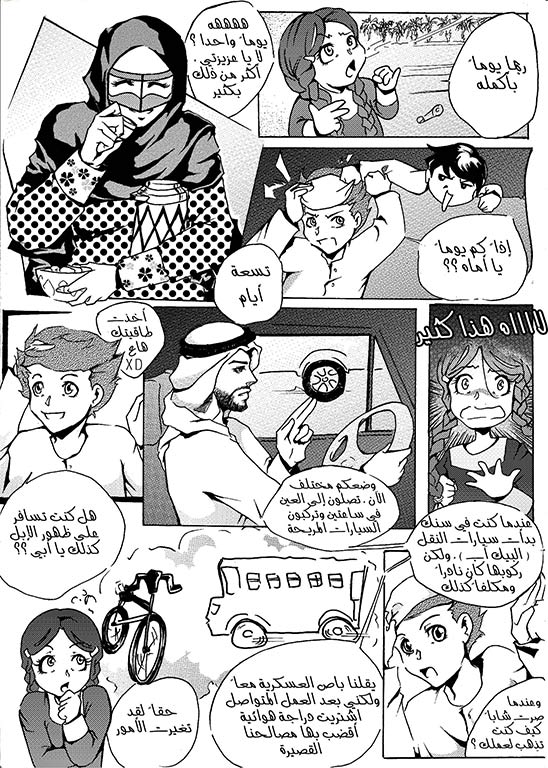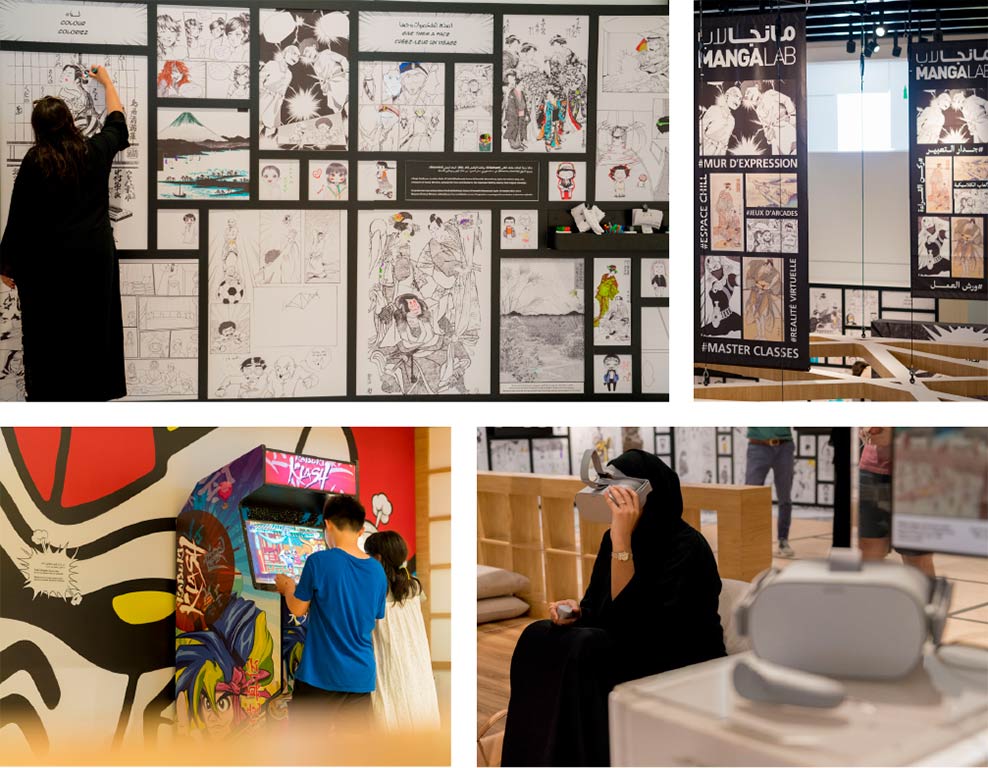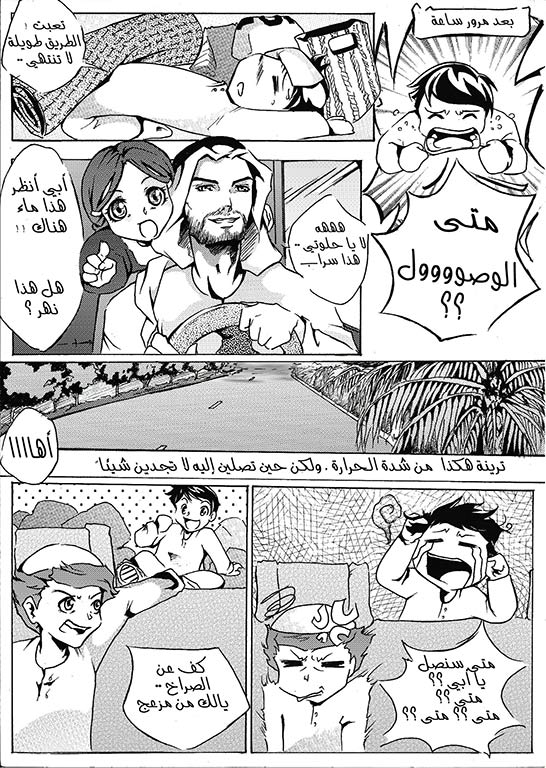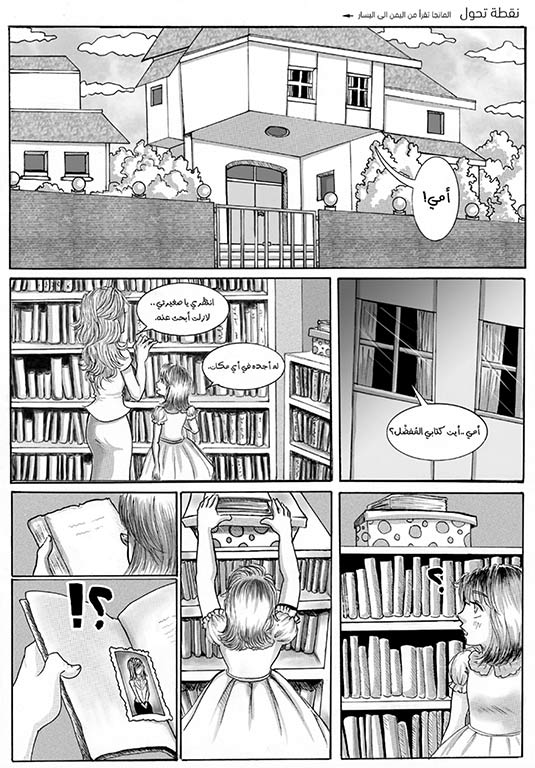Drawing Bridges
The Manga Lab at the Louvre Abu Dhabi celebrates the intermingling of cultures where cultural compounds are explored and art is not meant for display, but is catalytic to new expression.
Poonam Ganglani
It would be a wise choice to deposit all things prosaic at the door when you step into the Manga Lab. In this eclectic space at Louvre Abu Dhabi, the whims and colours of imagination leave no room for anything else. They are most strikingly visible in the surrounding wall panels, brought to life by semi-complete sketches and narratives in the style of manga and traditional Japanese art. Inviting the creativity of visitors to take free rein, the Expression Wall has featured spiky-haired characters with wide oval eyes, pouting women in bright kimonos and young Arab men in jazzy kandouras. The characters speak as many languages as the multicultural United Arab Emirates population, with words in Arabic, English, French, Japanese and Tagalog filling their speech bubbles.

‘The Manga Lab was originally conceptualised for the specific audience of teenagers and young adults,’ shares Anne Hauguel, the initiative’s project manager. ‘The idea was to dispel the notion of museums being dull places. The Manga Lab offers a space where they are free to stay and explore as much as they like.’ Accompanying Louvre Abu Dhabi’s Japanese Connections: The Birth of Modern Décor exhibition, the Manga Lab is indeed a unique kind of laboratory – one where ideas are experimented with, cultural compounds are explored and art is not meant for display, but is instead catalytic to new expression.
While it constitutes its own set-up within the museum’s forum area, the elements of the Manga Lab connect with the main exhibition in subtle ways. There are virtual reality pods, capturing the museum’s collection of traditional Japanese prints by Ukiyo-e master Katsushika Hokusai, whose 19th century compilation of sketches, Hokusai Manga, is recognised as one of the earliest forms of the art. There are also retro arcade games like Samurai Shodown, digital gateways into Japanese culture with objects and scenes from the same period as some of the exhibition pieces. A reading zone offers another window into narratives from Japan, while workshops animate the space during weekends.

The workshops are a particular draw among diverse groups of audiences, opening up the Manga Lab beyond its original ambit. ‘It was amazing to see the wide range of ages and nationalities around the table during a Japanese printing masterclass,’ shares Hauguel. ‘I’ve noticed that local visitors particularly enjoy the Manga Lab. One Friday, for example, a big group of Emirati students from Zayed University in Dubai arranged a trip to attend a masterclass led by Asami Art, an Emirati manga artist whom they follow on Instagram.’

Asmaa Al Remeithi, popularly known as ‘Asami Art’, is one among the four local artists whose work finds a place on the Manga Lab’s Expression Wall. Her work embraces the characteristic elements of manga, with hugely expressive eyes, hair in deft strokes, stylised speech bubbles and careful linear detail all operating as visual cues to the characters’ personalities and moods. While the situations in her work are fairly universal, her characters – before lending their speech bubbles to visitors’ voices – speak in Arabic, injecting a distinct Middle Eastern flavour.
The worlds of other Manga Lab artists like Maryam Al Atouly bear more pronounced imprints of Arab life. Keeping the usual design elements of manga intact, Al Atouly tells the story of an Emirati family on a trip to Abu Dhabi, featuring men in kandouras and ghutras, women in traditional face masks or burqas, and a few other indicators of Arab heritage and landscapes. ‘It’s interesting to see how the universe of manga is transported to their own local culture,’ says Hauguel. ‘Their work also shows how you don’t have to go all the way to Japan to find talented manga artists!’

It was, in fact, right next door in Dubai, at the Middle East Film and Comic Con, that Hauguel and her team met the artists who were to share their work at the Manga Lab, along with a host of other local artists passionate about the art form. ‘There’s a special interest in Japanese culture in the region and a real attraction to manga,’ shares Hauguel. Often a first bridge to Japan and its intriguing culture, Emirati artists have drawn inspiration from Japanese manga in unique ways to create their own version of Arabic manga – a fascinating hybrid between two distinctive sensibilities and psyches.
_________________________________________________________________________
All Images Courtesy of the Manga Lab, Louvre Abu Dhabi.
Share